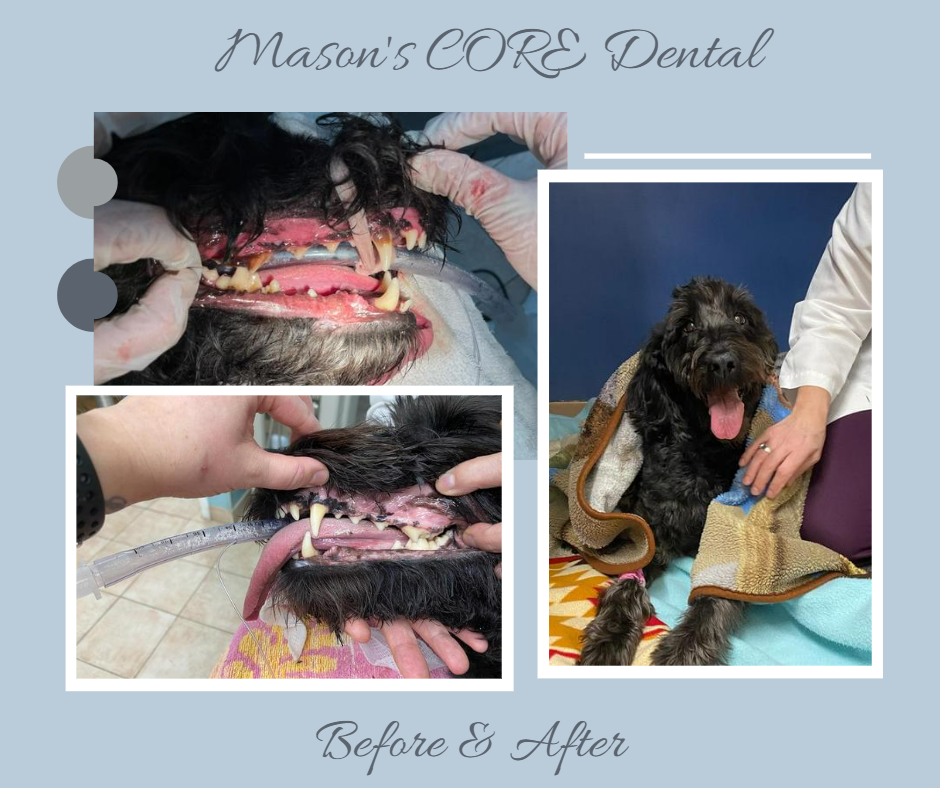Dental Cleaning
Don’t ignore your pet’s bad breath! Dental hygiene is often the cause of stinky breath, and it may indicate other important problems with your pet’s health.
Why Your Pet’s Dental Health is Important
When rough tartar accumulates on tooth surfaces and touches the gumline, it is time for a professional oral assessment, treatment, and prevention visit.
Don’t ignore your pet’s bad breath! Dental hygiene is often the cause of stinky breath, and it may indicate other important problems with your pet’s health. We understand how easy it is to miss. Many of the problems that stem from poor hygiene occur where you can’t see them below your pet’s gumline.
The first line of defense is always home care. But while some animals (especially dogs) tolerate their owners handling their mouths and brushing their teeth, most (especially cats) will struggle or act out. That can always make oral care difficult at best and ineffective at worst.

The best way to ensure your pet’s oral health is to have regular cleanings at our office. Discuss how often you ought to come in as well as a home hygiene regimen with your vet. This will also prevent dental issues from progressing to larger (and potentially deadly) internal issues, such as dysfunction or disease in the heart, kidneys, liver, or lungs.


What is involved with a dental exam?
A dental exam to confirm that a dental cleaning is needed is the first step. Your veterinarian will review with you what procedures are likely required prior to the dental cleaning. Your veterinarian may perform pre-anesthetic blood tests to ensure that kidney and liver function are satisfactory for anesthesia, as well as an evaluation of the heart and abdomen if needed. Anesthesia is important to allow a tooth-by-tooth examination, including dental X-rays.
How are my dog's teeth cleaned?
After a thorough examination of your dog’s mouth, tooth scaling will be performed, using both hand and ultrasonic scalers to remove plaque and tartar above and below the gumline. The tartar below the gumline causes the most significant periodontal disease, so it is important that it be thoroughly removed. After scaling, the teeth are polished to remove microscopic scratches and decrease the rate of subsequent plaque build-up.
Do I have to make an appointment for my dog to have a dental scaling and polishing?
Can I use human toothpaste?
Absolutely not. Human dentifrice or toothpaste should never be used in dogs or cats. Human teeth cleaning detergents contain ingredients that are not intended to be swallowed and can cause internal problems if they are swallowed. Human products also commonly contain higher levels of salt, which can be a problem for some pets.
You should also avoid using baking soda to clean your pet’s teeth. Baking soda has a high alkaline content, and if swallowed, it can upset the acid balance in the stomach and digestive tract.
Why is pet toothpaste recommended?
Pet toothpaste are non-foaming, safe to be swallowed, and are available in flavors that are appealing to dogs and cats, including poultry, beef, malt, and mint. If you use a product that tastes good, your dog will be more likely to enjoy the whole experience. In addition to the pleasant taste, many of these toothpaste contain enzymes that are designed to help break down plaque chemically, which reduces the time you need to actually spend brushing your pets teeth.
How can I prevent tartar accumulation?
Plaque forms in as little as six hours after your pet’s dental cleaning. At-home dental care is important to help reduce plaque build-up and improve overall oral health. The Veterinary Oral Health Council (VOHC) only accepts dental products that are safe and proven to reduce the accumulation of plaque and tartar based on strict scientific studies. A list of accepted products can be viewed at www.VOHC.org, and your veterinarian can advise you as well.
Why can't plaque and tartar be removed with a human dental scaler?
Although you can remove some of the accumulated plaque and tartar above the gumline in pets that are cooperative, there are four problems with doing this:
- Only the visible tartar above the gumline is removed. This leaves the plaque and tartar below the gumline, which will continue to cause periodontal problems.
- It is neither possible nor safe to clean the inner surfaces of the teeth properly in a conscious cat or dog.
- The use of any instrument on the tooth enamel will cause microscopic scratches on the surface, which will ultimately damage the tooth surface, leading to further disease. This is the reason your dental hygienist always polishes your teeth after removing tartar with dental instruments.
- If your pet moves suddenly, the sharp instrument may cut the gums, causing pain and bleeding.
What happens during a dental cleaning visit?
A dental cleaning visit will include a thorough dental examination, teeth cleaning, and polishing to remove the tartar and periodontal disease-causing plaque. This is done while your dog is under general anesthesia. Once anesthetized, your veterinarian, with the help of veterinary assistants, will thoroughly examine the mouth, noting abnormalities in the medical record. A dental probe will be used to evaluate gum bleeding and periodontal pockets, where food can accumulate and decay if not properly cared for.
When periodontal disease is advanced, it may not be possible to save the badly affected teeth, which may need to be extracted either during the procedure or at a later time. Your pet will be placed under general anesthesia to ensure proper dental care.
The treatment your dog may require will be discussed with you after the cleaning once each tooth and the gums have been checked. Since it can be difficult to predict the extent of dental disease in advance of the procedure, your veterinarian may contact you during the procedure to discuss any additional treatment that may be necessary.
